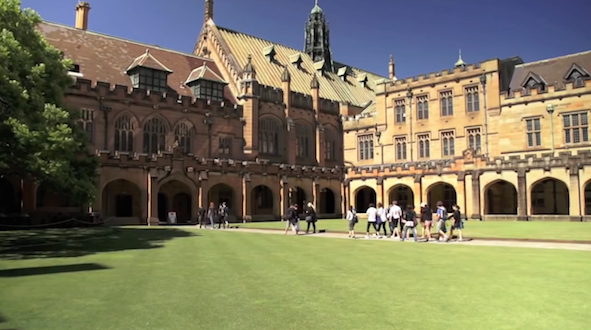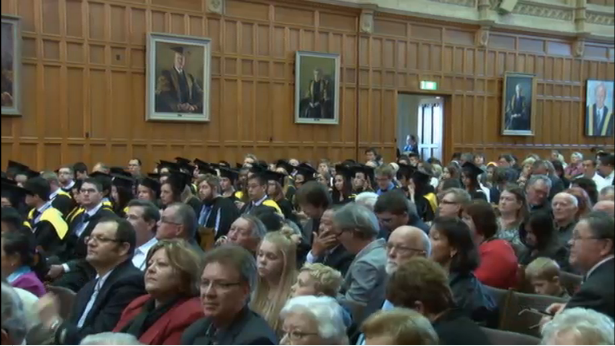A few years ago, when marketised universities took hold in the UK, a well known higher education commentator suggested that when students completed their studies they should be presented with receipts rather than degree certificates. The same sort of logic could be applied to today’s students who might be better served by visiting a financial adviser than a university campus.
The fact is that these days, if you’re considering a university degree, you simply have to do the math. Unless you’ve inherited a fortune and don’t need to care, you’ll need to calculate how much you’ll be indebted as a result of your studies as compared to what you’re likely to earn following graduation. This fiscal calibration assumes that upon graduation you’ll land the job of your choice. Unfortunately, as those with degrees in engineering, psychology, speech therapy, teaching, accounting, business studies and law can attest, a prolonged stint stacking shelves in Coles and Woolworths is the more likely outcome of their expensive tertiary education.
Understandably, these graduates are not the happy campers depicted in university marketing brochures.
And it’s even worse for international students who fork out up to three times more in upfront fees than their domestic counterparts. They arrive on these shores with high hopes of either obtaining a permanent visa or heading back home to a plum job. Neither possibility will necessarily eventuate. You really do have to sympathize with this band of tertiary consumers – after all, about 20 per cent of them come from grindingly poor families in developing countries for whom an Australian higher education is seen as a passport to a better life. It might not be.
To add insult to injury, during the course of their studies many international students have to endure crappy, overcrowded housing in distant suburbs or inner-city hovels, and have little or no access to legal, welfare and social services. Significant numbers report feeling isolated, lonely and estranged from their institutions, and many fail to make friends with domestic students, often because of language difficulties and complex cultural issues. To get through their studies a lot of international students have to work long hours, often in low paid, casual and illegal jobs in the shadow economy.
But it’s all worth, isn’t it? Well, yes and no. It’s certainly worth it for universities and the Australian economy with international students now contributing a whopping $16 billion per annum to the nation’s coffers. But do students get value for money? University chiefs will of course promise them the earth – career paths leading to senior management positions and chunky salary packages.
The reality however, is a little more complicated. For those fresh-faced graduates heading back to China, for instance, many will find their desired jobs hard to come by, mainly because domestically educated graduates – those with degrees from ‘world class’ Chinese universities – are getting employed ahead of their Australian educated peers.
Why? Well, partly because they posses better English language and other job related skills as well as more realistic expectations – which says a lot about the quality of university education in Australia. To make matters worse, there are already too many graduates in certain fields in China and the number of domestic degree holders is on the rise, so it’s a much more competitive job market.
It’s also far from rosy for domestic students – or their employers – in Australia. As numerous employer surveys are telling us, Australian bosses are often bitterly disappointed by the quality of graduates emerging from our universities, with many lacking some of the most basic job skills, but certainly not without lofty expectations of a fast tracked career. So disillusioned have some employers become that more and more of them have, if not entirely given up on graduates, sought instead to broaden their recruitment policies by focusing on demonstrable skills and aptitudes rather than qualifications per se.
Over the past few years I’ve been interested in the obvious gulf (chasm might be a better word) that exists between all the marketing hype and the reality of university education for our increasingly indebted students. I’ve spoken to hundreds of students – under-graduates and post-graduates, on-campus and online, domestic and international, men and women, young and mature-aged. What I’ve learnt is that if you were to rigidly apply the provisions of the 1974 Trades Practices Act, and/or set the ABC Checkout team to work, you’d soon uncover a significant number of cases of, let’s call it ‘misleading advertising’.
Some universities are extremely economical with the truth when it comes to the nature and quality of university education, and all of them actively seek to sell what are now regarded as ‘products’ and ‘services’ to ‘consumers’. Glossy brochures, impressive websites, glitzy open days, expos and social media campaigns are used to entice shoppers into the fold.
The tag lines, slogans and messaging are breathtaking in their scope and unintended hilarity. These are the same sorts of marketing gimmicks employed by companies that sell condoms, corn flakes, brake fluid and floor cleaners. Take for example the following advertising nonsense recently culled from a number of websites and newspapers: ‘Are you reaching your potential?’ (Australian Catholic University); ‘Join the most wanted list’ (University of New South Wales); ‘Bring ambition to life’ (Bond University); ‘When you’ve gone as far as you can go’ (Curtin University); ‘Curious about your true potential’ (Charles Sturt University); ‘Shaping futures’ (University of Newcastle); and, ‘Dream large’ (University of Melbourne).
Whether or not such idiotic one-liners would persuade someone to enrol in a diploma, masters or doctoral program is open to question, although hard sell at expos and open days, the lure of scholarships, countless inducements (like free i-pads and shopping discounts), or of becoming one of Australia’s ‘top CEOs’ (as promised by the University of New South Wales), or having the opportunity to ‘supercharge your career’ (as marketed by the University of Western Sydney), may well do the trick.

Given that universities are still heavily reliant on enrolments for their revenue you can understand why they are so desperate to snare prospective students.
This is particularly the case for the regional and inner-city redbrick universities who go to extraordinary lengths to enrol students, especially those ‘walking ATMs’ from overseas.
Many institutions, like Southern Cross in regional NSW, pride themselves on having the nation’s most flexible entry schemes, while others open their doors to students with bargain-basement ATAR scores, claiming that these scores are nothing more than an indicator of supply and demand.
‘What’s education got to do with it?’ you might well ask. Many of these same students entering higher education have serious literacy problems, the result of which is that universities have to provide all manner of support services to ‘at risk’ students, and lecturers are faced with the burdensome task of having to mark assignments written in what looks like ancient Greek. Many academics rightly attribute this to the world’s most elastic entry policies.
Take La Trobe University in Melbourne which, from what I can tell, has entry policies so flexible that just about the entire adult population of Australia is eligible to enrol. The university offers special entry schemes access programs, pathways, and various ‘alternative’ entry routes for those under 21 years of age and those over 21 years of age. If you’ve experienced ‘disrupted schooling’, have ‘home environment responsibilities’, a ‘medical condition’, or are ‘mature-aged’, from a rural and regional area; or if you face ‘difficult circumstances’, or are from a ‘disadvantaged financial background’ then you can apply for special consideration.
While these and many other entry points have been around for some time, they are now supplemented by a bevy of highly creative points systems which enable institutions to inflate ‘selection rank’ scores. For example, at Macquarie University in Sydney, bonus points are granted to prospective students on the basis of proven socio-economic disadvantage, or to ‘elite athletes and performers’ who believe that their performing, training and/or competitive commitments have affected their studies. Intriguingly, ‘elite’ candidates have to prove their academic performance has been ‘impeded’ by their devotion to sports or performing arts and, if successful, are granted four bonus points.
No-one of course is suggesting that entry should be restricted simply to those who gain a decent ATAR score, but the degree of flexibility demonstrated in university entry programs is probably driven as much by financial considerations as by concerns over equity. It’s perhaps not surprising therefore that dropout rates among students with low ATAR scores and those from disadvantaged backgrounds are significantly higher than other student cohorts.
There’s no doubting that poverty, and ‘socio-economic disadvantage’ do have an important bearing on the student experience. As noted in a 2012 report by the Centre for the Study of Higher Education at the University of Melbourne, more than half of full-time undergraduate students experienced ‘income deficit’, meaning that expenditure exceeded income. How could it be otherwise when more than two-thirds of full-time undergraduates received $20,000 or less per annum, while just under a quarter pulled in no more than $10,000? Equally worrying, three out five international students were surviving on just $20,000 or less a year, with many having to seek on-going support from their families. Sixty per cent of international students in employment worked 11–17 hours per week during semester, often in illegal and low-paid work. Many were also drawing from their savings just to get by.
Perhaps the main concern for our budget-conscious universities is that financially stressed students are more likely to drop out. As the report notes: “The concern these students express about their financial situation is not unjustified and has real, negative outcomes for them: they are around three times as likely to have had to defer because of finances at some point than are others. And, most tellingly, one in four of those who often worry about finances… indicate that they regularly go without food or other necessities because they cannot afford them.”
Rent, travel, food and various incidentals accounted for most students’ expenditure, although increasingly, the costs of textbooks and various course-related fees and charges also contributed to their financial woes.
But that’s not the end of the story. First year experience surveys tell us that about a fifth of these students report feeling lonely and isolated and haven’t made a friend since the start of the year, and that over a quarter cannot identify with their institutions. The reasons for this are complex but are to do with the fact about 80 per cent of students work, travel into campus from long distances, cannot afford to live on campus, increasingly undertake their studies online, and have ‘work-life balance’ challenges. They also find themselves in bloated classes with teacher-student ratios in tutorials varying from anywhere between 20 up to 60. Lecturers are often too stressed/busy/preoccupied to talk to students outside of crammed consultation times.
In short, being at university can feel like a drive through experience, typified by fleeting relationships and functional education. Universities like to sell the idea of a vibrant campus life, but it’s more of an illusion than reality. As a survey of 6,500 students conducted by the National Union of Students revealed, the majority of respondents had serious gripes about the quality of teaching, poor facilities and general lack of support.
Overcrowded lecture theatres and bulging tutorials were also common concerns, as were lack of adequate feedback from lecturers, and insufficient learning materials. Many respondents also noted that the technology wasn’t always up to scratch (much of it antiquated, in states of disrepair) and that lecturers were often unfamiliar with the latest techno-gadgetry.

Equally concerning were things you might not expect in one of today’s, upmarket institutions: flooded classrooms, leaky roofs, cracked windows, uncomfortable wooden seats, dingy and rundown rooms with inadequate ventilation, cramped space for large classes, poorly sound-proofed and cold lecture theatres, obsolete or broken equipment, lack of laboratory equipment and insufficient or poorly trained supervisory staff, and dirty and hazardous laboratories.
Other students talked of loneliness, lack of campus life, financial problems, expensive and unobtainable textbooks, and a limited range of units, ‘patchy’ and ‘average’ teaching, and poor course delivery. Difficulties in staff communication between campuses, lack of interaction between teaching staff and inadequate support also figured among the students’ complaints.
Not that you’re likely to hear much about any of this in the marketing brochures which are full of references to excellence, flexibility, opportunity, innovation, world class education, and so forth. But you will hear a lot about jobs and careers, endless amounts thereof. The link between job aspirations, business requirements, the economy, productivity and GDP could not be more pronounced in the modern university. These are core elements of the neoliberal university and much about its curricula reflects this orientation – the emphasis on job readiness, graduate attributes, and overly rigid learning objectives, performance outcomes, etc.
The business ethic is also reflected in the organisational cultures of universities in which our million dollar vice chancellors – most of whom received free education on campus – are like corporate CEOs presiding over institutions more like private firms than centres of higher learning. Nearly all our VCs – apart from one notable exception – supported (indeed advocated for) the Coalition government’s attempt to deregulate fees, and most are huge fans of online education because of its potential for access to lucrative global markets and lower infrastructure costs. University Inc might claim educational excellence as its primary motive but it’s really the financial imperative that tends to run the show.
That’s the problem in a policy environment that looks to the US (with its trillion dollar plus student debt and woeful higher education offerings) for its example of excellence, while turning away from policies in countries like Sweden and Germany, where there is free access to higher education.
The latter simply do not fit the neoliberal agenda, even though it seems to work in some of the world’s richest nations.
Education minister, Christopher Pyne places great faith in the hidden hand of the market to resolve all the problems faced by universities, while ignoring the grotesque consequences that come from a lack of planning and the creation of a generation of debt slaves.
Take a peek beyond the marketing hype and you’ll soon discover that the neoliberal university is failing most of the tests it sets itself, and its graduates and society as a whole that pays the ultimate price.
*This article is based on extracts from Richard Hil’s new book: Selling Students Short: Why you won’t get the university education you deserve (Allen & Unwin). Richard Hil is Adjunct Associate Professor in the School of Human Services and Social Work at Griffith University (Gold Coast), and co-founder of the Ngara Institute.
Donate To New Matilda
New Matilda is a small, independent media outlet. We survive through reader contributions, and never losing a lawsuit. If you got something from this article, giving something back helps us to continue speaking truth to power. Every little bit counts.



